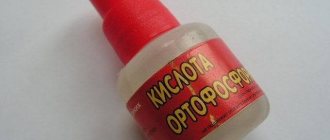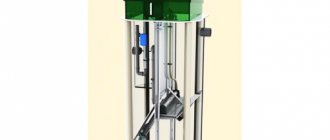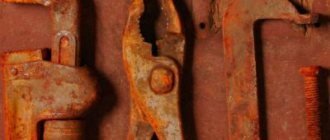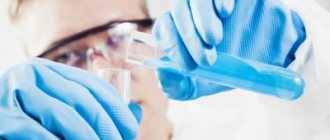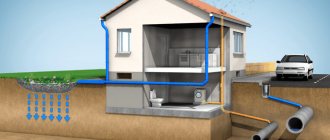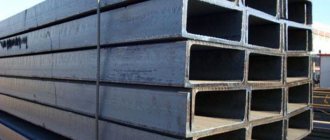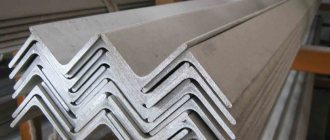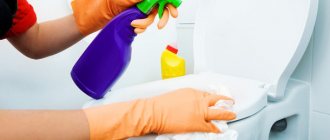Oxygen, water and carbon dioxide cause metal corrosion.
It’s especially unfortunate when a car corrodes. Not everyone knows that these injuries can be dealt with. The use of orthophosphoric acid against rust in a car is known to many. Orthophosphoric acid is an inorganic water-soluble product. An apparently colorless liquid, it is available in the form of an 85% aqueous solution. The properties of this acid make it possible not only to remove oxides on the metal, but also to form a grayish protective film that prevents the appearance of new rust.
What is phosphoric acid
Orthophosphoric acid is an inorganic water-soluble type product. Produced as an 85% aqueous solution. The substance looks like syrup and has no color.
Phosphoric acid not only removes loose oxides, but also forms a grayish protective film of an oily consistency. The protection mechanism is the formation of a phosphated surface after the acid eats away the iron oxide.
Phosphoric acid has a wide variety of uses. However, if we talk about protecting surfaces from corrosive processes, the scope of application of acid is also wide: from processing technological equipment to protecting car parts. Phosphoric acid is included in metal primers and rust converters. Moreover, in the latter case, the acid acts as a basic element.
Advantages of orthophosphoric acid:
- Removes rust deposits on metal surfaces, as well as on enamel and earthenware products.
- Rust removal occurs delicately, without damaging the surface (for example, acid does not damage the enamel).
- A protective film appears on the surface of the metal, preventing the development of corrosion processes and mechanical damage.
- In addition to its protective functions, the cleaning qualities of phosphoric acid are known - it is used to remove plaque and dirt from all kinds of plumbing fixtures.
Traditional methods
The main rules when using any of these products are strict adherence to the exposure time to prevent damage to the product itself and thorough drying to delay re-corrosion.
Aluminium foil
In this case, the foil acts as an analogue of an abrasive brush, that is, it has an exclusively mechanical effect. A piece of foil must be crumpled into a tight ball that can be used to clean the surface. It is worth considering that this method is suitable for minor stains on household appliances. But to clean rusty pipes it is better to use chemicals.
You can remove rust from such areas and give them a smooth look using a crumpled up ball of aluminum foil.
Vinegar
It is worth using white vinegar, since its flavored and colored analogues not only will not help remove dirt, but can also leave new stains. The operating procedure is as follows:
- pour vinegar into a spray bottle;
- apply the substance to the affected area;
- leave the treated surface for a couple of hours;
- remove plaque with a wire brush;
- wash off traces of vinegar with warm water;
- Dry the treated area in the sun or wipe thoroughly with a rag.
Vinegar is the most popular and affordable means for removing corrosive deposits from metal products and more.
Soda
Effective enough for small stains. Soda must be diluted with water to obtain a paste-like mass, which should be applied to the surface in a thick layer. After half an hour, the plaque can be easily removed with a metal sponge or brush.
If necessary, the procedure can be repeated.
Lemon acid
A fairly effective remedy with a number of advantages:
- availability;
- maintaining the appearance of paint covering a metal product;
- absence of aggressive chemicals;
- harmless to the skin of the hands (the use of gloves is still recommended).
This method removes corrosion in all hard-to-reach places.
Before starting work, the metal surface must be degreased, which can be done using dishwashing detergent. Next, the product is placed in a concentrated solution (80 g of citric acid per 100 ml of warm water) for several hours. In this case, the reaction begins within a few minutes, as indicated by the formation of bubbles. After the reaction is completed, the surface should be washed under running water, if necessary, removing remaining contamination with a wire brush.
Oxalic acid
The algorithm for working with this substance is as follows:
- wash the rusted product using any dishwashing detergent;
- dry thoroughly;
- mix six teaspoons of oxalic acid with 300 ml of water;
- immerse the object in the solution for half an hour;
- remove rust residues with a stiff brush;
- dry the product thoroughly.
When using it, you must adhere to safety precautions: wear safety glasses and rubber gloves.
Hydrochloric acid
A 2% hydrochloric acid solution will effectively clean rust from a white item. In this case, it is enough to simply treat the item to be cleaned with acid until the contamination disappears. Afterwards, it must be rinsed in a solution of ammonia and water (a couple of tablespoons of ammonia per liter of water).
Using this product, you can effectively clean rust from white items.
Hydrogen peroxide
This substance has oxidizing and reducing properties, which allows it to effectively remove traces of rust from objects such as a bathtub, toilet bowl, knives or tools.
Hydrogen peroxide is used according to the following scheme:
dilute four tablespoons of trisodium phosphate powder in three liters of water; carefully pour 50 ml of peroxide into the solution, dividing into five portions; soak the product in the mixture for half an hour; thoroughly wipe the treated area with a regular sponge, then leave the product for another ten minutes; rinse the surface with clean water.
Coca-Cola
This drink contains phosphoric acid, and therefore can be used to remove rust. It is enough to place the damaged product in liquid for 25-30 hours, after which it should be rinsed with clean water and wiped dry.
Surely many housewives have heard that you can remove rust with cola.
Safety precautions when working with acid
Phosphoric acid is classified as a hazardous chemical. Contact of this substance with skin may result in painful burns. The substance also releases harmful vapors that are dangerous to the respiratory tract.
Based on the above, transportation, storage and work with this material requires compliance with certain safety standards. You can work with phosphoric acid only in protective clothing, gloves and a respirator.
In case of unwanted contact of the substance with the skin, the following actions must be taken:
- First of all, you need to remove clothing that has been exposed to harmful liquid.
- Next, rinse the affected area of skin with a significant amount of water. It is best if it is running water. The approximate duration of washing is 15-20 minutes.
- Under no circumstances should you rub the liquid over your skin. The substance should not be wiped off with napkins or a towel, but rather washed off.
- Sometimes a one-time rinse does not help. In this case, you need to extend the procedure for another 15-20 minutes. It is recommended to do the same if the burning sensation recurs after some time.
- Before the doctor arrives, it is recommended to apply a loose (non-constricting) gauze bandage to the affected area.
- If the pain syndrome is too bothersome, you can take a painkiller (for example, analgin).
So, all work with orthophosphoric acid must be carried out with extreme care and attention. If the incident does occur, then after providing primary assistance to the victim, you should immediately consult a doctor.
Pros and cons of a homemade product
The anti-rust product, made by yourself, has a number of advantages. However, it cannot completely replace professional converters. Due to the existing disadvantages, many users prefer ready-made store-bought chemicals. For an objective assessment, it is necessary to consider both the pros and cons.
Homemade composition is valued for the fact that it:
It is not toxic to humans, as it consists of harmless substances.- Does not require very complex and time-consuming manufacturing technology.
- Has simple and clear instructions for use.
- Helps achieve rust removal and coating protection.
- It is much cheaper than branded analogues.
The disadvantages of a homemade converter make its use limited and reduce its popularity among motorists, housewives and production workers.
The weak points of the homemade corrosion modifier are:
- The need to find a convenient container and method of application.
- Can only be used with a thin layer of rust.
- Lower efficiency compared to special means.
- The need for mandatory coating of the product with paint or varnish.
Rust removal
Based on the degree of the corrosion process and the size of the product being cleaned, a rust removal method is selected:
- etching with immersion in solution;
- single or multiple treatment of the part with phosphoric acid (roller or spray);
- metal processing with preliminary mechanical cleaning.
Immersion etching of products
For etching you will need a lot of acid and a container corresponding to the size of the part. It is best to carry out etching using the full immersion method.
Work order:
- degrease the part using any household chemical;
- thoroughly rinse the product in running water;
- fill the container with a solution in the following proportion: 100-150 grams of acid per liter of water;
- immerse the product in the container and leave it for an hour, remembering to periodically stir the solution;
- we take out and wash the part;
- We prepare a neutralizer solution with the following ratio of components: 50% water, 48% alcohol, 2% ammonia;
- wash the product with an alcohol solution and then with running water;
- dry the part using any method (for example, convection).
It is important to follow the sequence of operations, because they are connected. For example, without degreasing, the etching will be uneven. If the part is not thoroughly dried after processing, hydroxide will appear on it, which is extremely undesirable.
Applying acid to the surface
If the product is large, there is no suitable container for it, or the supply of powder is not too large, you can treat the surface using a spray bottle, roller or brush. Before processing the part, you need to carry out preparatory work: remove rust, clean and degrease the part.
The degree of corrosion process must be taken into account. If there is too much rust, you may have to use an angle grinder with a wire brush or flap wheel attachment. However, rust should be removed carefully so that holes do not form if the metal is too thin. Abrasives with grains that are too coarse should be avoided.
Phosphoric acid is a powerful agent, so if you are not careful, you can damage the decorative layer.
Before applying the composition, it is necessary to clean the surface with a brush, and then degrease the material with a detergent composition. After degreasing, the surface is washed with water and dried well. Next, you can apply the acid.
A couple of hours after treating the surface, the acid is washed off using an alcohol neutralizer solution, the recipe for which is indicated above. Then the surface is washed with water and dried.
Advice! A retarding substance (inhibitor) called “Katapin” can be added to the acid composition. This drug reduces the rate of reaction with unoxidized metal. Add 1-2 grams of Catapina per liter of water.
Removing rust from plumbing fixtures
Phosphoric acid is also used as a household chemical. Using this substance, traces of rust can be easily removed from areas where water regularly drains in toilets and enamel bathtubs.
Note! Phosphoric acid is not applicable to acrylic baths.
Instructions for removing rust from earthenware and enameled products:
- degrease the surface using any detergent;
- clean the surface with a brush with natural bristles;
- mix 100 grams of 85% composition with 500 milliliters of water;
- apply the solution to the surface;
- after a certain time (from 2 to 12 hours, depending on the amount of oxides), wash off the composition with a soda solution (a liter of water per tablespoon of soda).
The peculiarity of this cleaning method is that there is no need for rubbing movements, which could lead to damage to the enamel surface.
Interesting information! Some housewives use Coca-Cola to remove rust deposits. The secret of the cleansing effect of the drink is that it contains a small amount of phosphoric acid. However, the effectiveness of this method is still insufficient, so it is more correct to use a composition with an 85% concentration.
Cleaning rust by applying orthophosphoric acid to the surface
If a large part of the car has suffered from rust and it is not possible to immerse it completely in the solution. Or the amount of reagent is very limited, another method can be used.
Here, too, it is necessary to clean and degrease the surface. If the degree of rust is high, you may need to use a grinder. The attachment can be a metal brush. Next, orthophosphoric acid is applied in a convenient way. After a few hours the surface can be neutralized and cleaned. You should be careful with decorative coatings on metal; it is not friendly to all of them.
Advice!
Phosphoric acid interacts not only with oxidized iron, but also with the rest of the metal. This can cause thinning and holes in the surface. This process can be stopped using the inhibitor "Katapin". Per liter of water, 1 gram of this neutralizing substance is required.
Rust converter
A rust modifier is the same solution of phosphoric acid, but with special additives. There are several types of converters:
- primers;
- stabilizers;
- converters.
An example of primers is the composition “EVA-0112”, which includes a base and 85% phosphoric acid. The composition is used for priming steel surfaces for painting.
The converter under the Tsinkar trademark contains acid, as well as zinc and manganese salts. As a result of the transformation of rust, the alloying effect is transferred to the metal and a protective layer is formed on its surface.
Note! It is recommended to use the converter only after reading the instructions.
Rules for transporting orthophosphoric acid
Phosphoric acid is an aggressive substance, so the powder must be placed in an insulated container. It is important to prevent foreign substances from entering the acid. Containers for storing and transporting the substance must be dry and clean. Only if these requirements are met can a solution of proper quality be obtained. If the composition turns out to be of poor quality, there is a high probability of releasing harmful fumes. In addition, using a low-quality solution will not protect the metal.
The container with the powder should be stored in a warm and dry place. Avoid damp places where condensation may form. It is not recommended to pour the powder into another container; it is advisable to store it in the original packaging. Since the cargo is classified as hazardous substances, accompanying documentation will be required to move it over significant distances.
Basic rules when using phosphoric acid to remove rust
- Before starting the main work, it is necessary to prepare all protective equipment, since the substance is aggressive and leaves burns if it comes into contact with the skin.
- First, the surface must be cleaned of normal contaminants so that the product can perform its functions fully, otherwise the surface will be cleaned in parts.
- If the rust layer is too thick, then it is necessary to resort to mechanical cleaning of the surface; for this, use a grinder and a metal brush.
- The cleansing area must be degreased and then rinsed with water so that the product adheres well and works effectively.
- After finishing the cleansing, the acid must be washed off with a neutral solution and then with water.
- Since the substance is aggressive, it can damage the main surface, so it must be covered with film.
- If it is not possible to clean by immersion, then use sprayers or apply acid with a brush or roller to the rusty surface.
- If the surface is not clean after the first application, additional spraying will be required. After this, the area to be cleaned must be washed with a neutral solution and then with water.
- Phosphoric acid cannot be used to clean rust on acrylic surfaces.
Tips for choosing a rust remover
When choosing a product to remove traces of corrosion, you need to proceed from the situation. If you plan to clean surfaces using the immersion method, you will need a lot of acid. In this case, it is recommended to purchase 85% phosphoric acid. If there is a need not only to remove rust, but also to create a protective film under the paint, then you won’t be able to make the solution yourself. In this situation, it is more correct to purchase a factory-made converter, which contains all the necessary additives.
In addition, you need to know whether the surface is planned to be primed. Converter-modifiers improve the inhibitory and hydrophobic qualities of the primer composition, but still do not belong to primers. In such cases, priming converters will help, after processing, with which a paint and varnish composition can be applied to the surface.
How and with what to remove rust from metal
Removing traces of corrosion from various objects has its own specifics that must be taken into account.
From the body of a car
Rust often forms on the car body. The following products are best suited to remove it:
- Orthophosphoric acid. Its solution is applied to a sponge, which is used to wipe the car body.
- Zinc. Mixtures are made from it that allow you to get rid of contamination after the first treatment.
From a water tap
The optimal remedy for rust on metal, especially for cleaning enameled metal surfaces, is Adrilan, produced for washing household appliances. Since it is very concentrated, it is diluted in warm water before use.
An effective cleaning agent, and not only against rust, but also against any contaminants.
From a bicycle
You can easily get rid of rust stains that appear on a bicycle frame over time using citric acid. Moreover, before removing rust from metal, the surface must be degreased, and then rinsed and dried thoroughly.
From skates
If skates are stored for a long time in conditions of high humidity, a rusty coating begins to form on them. You can remove it using a mixture of baking soda and lemon juice. To do this, the components are mixed until a mushy substance is obtained, which must be applied to the contaminated surface for an hour and a half. After this, the skates need to be washed and dried.
Effective folk remedies will help eliminate rust stains from skates.
From a horseshoe
An old rusty horseshoe can be cleaned with oxalic acid. To create a solution, you need to mix acid and boiled water in a ratio of 1 to 12. A horseshoe is placed in the resulting liquid for forty minutes, after which it is washed with running water.
From the tools
Metal tools that are rarely used will corrode over time. You can clean them from rusty deposits using a vinegar solution. To prepare it, you need to mix white vinegar with warm water in equal proportions. The resulting liquid is applied to contaminated instruments, after which they can be easily cleaned with a wire brush or sponge.
Pour vinegar into a container large enough to fit the spoiled item. Immerse the product in a container with product.
Once cleaned, polished metal instruments can be treated with a solution of gasoline and wax or paraffin to protect them from further corrosion. To obtain it, you need to add paraffin or wax to gasoline heated in a water bath.
From the nut
You can clean the nuts from corrosive deposits using a vinegar solution. To do this, dilute 100 ml of white vinegar in a bucket of water, after which all rusted nuts are placed in a container for three to four hours. After this time, the nuts are washed with clean water and wiped off any remaining rust.
Cleaning small household items
All of the above methods can be used to clean small metal objects. The only difference is the ability to place the rusty product entirely into the product being used.
Follow all the above rules and you will notice that rust can be removed quickly and without much effort.
Burnishing with phosphoric acid
Blueing, i.e. The production of iron oxides on a steel surface can be carried out using the Parker method.
Instructions:
- We take a 60-85% acid solution and put steel filings in it for 2 weeks. The container must be carefully sealed.
- We clean and degrease items to be oxidized.
- Place the product in the aged solution and boil the liquid for 30-45 minutes. Depending on the brand of metal, the surface will acquire a gray or black matte tint.
Note! Do not keep the product in boiling water for too long, otherwise the oxidized surface may be corroded.
At the end of the article, I would like to remind you that phosphoric acid is an intermediate solution. If you leave the coating unpainted, sooner or later the metal will corrode.
Methods for preventing corrosion in industry
Galvanization
How do you remove rust in production? Galvanization is often used. A zinc layer is applied to the product. Zinc is inexpensive and has excellent adhesion to steel. In more aggressive conditions it is better to use cadmium. Aluminum is often used today. It migrates into the coating, covers scratches, and provides long-lasting protection.
Read also: Az431 description in Russian
Cathodic protection
How do you remove rust from metal, other than galvanization? Cathodic protection is considered a method that is used to prevent corrosion processes in underground/water-borne structures by means of an electrical charge that suppresses electrochemical reactions. The sacrificial anode must be made of a material having an electrode potential that is more negative than that of iron/steel.
Special coatings
How to clean rust? To do this, you can use varnishes, paints, and other special means that isolate the metal from the environment. Large surfaces that are divided into sections (hulls of ships, cars) are often covered with wax-based products.
The following methods are used:
- galvanizing – a zinc layer is applied to the metal;
- tinning – soft steel sheet is coated with a tin layer;
- chrome plating – a thin chrome layer is applied to the metal, providing protection and good appearance. Often used to improve the corrosion resistance of vehicles.
If you are concerned about rust on iron products, know that a solution like this is an excellent method of combating it. Before removing rust using this “cocktail,” remove all loose flakes by hand.
Now you know how to get rid of rust yourself. Follow the above rules. If you hold an iron object in one of the above liquids for too long, it will become deformed.
You can choose any method. The main thing is to clearly understand how to stop rust. If you do not understand something, it is better to re-read it again or consult with a knowledgeable person. When removing rust with vinegar or other acid, be careful not to burn yourself. Getting a burn injury is not a very pleasant prospect.
We also recommend reading:
The home craftsman uses a variety of workpieces in his work; often they were not stored in the best conditions. Therefore, the question of how to quickly remove rust from metal at home is quite relevant.
Some people cannot immediately find the optimal path. Time-tested folk remedies are often used to solve the problem of rust control.
